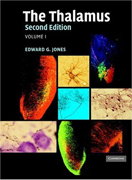Edward G. Jones’ The Thalamus is one of the most cited publications
in neuroscience. Now more than 20 years on from its first printing,
the author has completely rewritten his landmark volume,
incorporating the numerous developments in research and understanding
of the mammalian thalamus. As a leading authority on thalamus biology
and function, Edward G. Jones shows how knowledge of the thalamus has
developed with the introduction of new technologies and ideas. The
author's photographic skills are exhibited in brilliant preparations
of thalamic structure in a wide range of common and uncommon species.
The Thalamus is both an up-to-date scientific review of virtually all
aspects of forebrain function and a work of immense neuroscientific
scholarship. It forms an essential reference for neuroanatomists,
neurophysiologists, molecular neurobiologists, developmental
neurobiologists and clinicians its deep historical perspective will
be of value to historians of science.
----------------------------------------------------------------------
----------
목차
차 례
Part I. History: 1. The history of the thalamus;
Part II. Fundamental Principles: 2. Descriptions of the thalamus in
representative mammals; 3. Principles of thalamic organization; 4.
Thalamic neurons, synaptic organization and functional properties; 5.
Chemistry of the thalamus;
Part III. Development: 6. Development of the thalamus;
Part IV. Individual Thalamic Nuclei: 7. Ventral nuclei; 8. Medial
geniculate complex; 9. Lateral geniculate nucleus; 10. Lateral
posterior and pulvinar nuclei; 11. Posterior complex of nuclei; 12.
Intralaminar nuclei; 13. Medial nuclei; 14. Anterior nuclei and
lateral dorsal nucleus; 15. Ventral thalamus; 16. Epithalamus;
Part V. Comparative Structure: 17. Comparative anatomy of the
thalamus; 18. The human thalamus; Part VI. Conclusions: 19.
Concluding remarks; References; Index.


